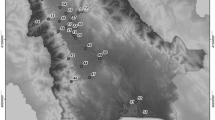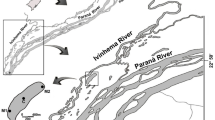Abstract
The distribution pattern of 115 chironomid taxa at 664 sites, distributed over all kinds of water, was analyzed and related to 42 water types, based on the complete macrofauna composition. The distinction of chironomid groups was not useful to recognize water types. The use of individual chironomid taxa was more sensitive, though also too limited to recognize water types clearly. Chironomids are distributed along a continuum which is directed by master factors and detailed by habitat factors.
Similar content being viewed by others
References
AAGAARD, K., 1986. The chironomid fauna of Norwegian lakes, with a discussion on methods of community classification. Holarct. Ecol., 9: 1–12.
BRUNDIN, L., 1958. The bottom faunistical lake type and its application to the southern hemisphere. Moreover a theory of glacial erosion as a factor of productivity in lakes and oceans. Verh. Int. Ver. Limnol., 13: 288–297.
HILL, M.O., 1979. TWINSPAN-A FORTRAN program for arranging multivariate data in an ordered two-way table by classification of the individuals and attributes. Ecol. Syst., Cornell Univ., New York. 90 pp.
JOHNSON, R.K. and T. WIEDERHOLM, 1989. Classification and ordination of profundal macroinvertebrate communities in nutrient poor, oligomesohumic lakes in relation to environmental data. Freshwat. Biol., 21: 375–386.
MINSHALL, G.W., K.W. CUMMINS, R.C. PETERSEN, C.E. CUSHING, D.A. BRUNS, J.R. SEDELL and R.L. VANNOTE, 1985. Development in stream ecosystem theory. Can. J. Fish. Aquat. Sci., 42:1045–1055.
OMEROD, S.J., 1987. The influences of habitat and seasonal sampling regimes on the ordination and classification of macroinvertebrate assemblages in the catchment of the river Wye, Wales. Hydrobiologia, 150: 143–151.
PEET, R.K. 1980. Ordination as a tool for analyzing complex data sets. Vegetatio, 42: 171–174.
PRESTON, F.W., 1962. The canonical distribution of commonness and rarity. Ecology, 43: 185–215.
RAE, J.G., 1985. A multivariate study of resource partitioning in soft bottom lotic Chironomidae. Hydrobiologia, 126: 275–285.
TER BRAAK, C.J.F., 1987. CANOCO-A FORTRAN program for canonical community ordination by [partial] [detrended] [canonical] corre spondence analysis, principal component analysis and redundancy analysis (version 2.1). TNO Institute of Applied Computer Science, Wageningen, The Netherlands.
VAN TONGEREN, O., 1986. FLEXCLUS, an interactive flexible cluster program. Acta Bot. Neerl., 35: 137–142.
VERDONSCHOT, P.F.M., 1990. Ecological characterization of surface waters in the province of Overijssel (The Netherlands). Thesis, Agricultural University, Wageningen. 255 p.
WRIGHT, J.F., D. MOSS P.D. ARMITAGE and M. T. FURSE, 1984. A preliminary classification of running-water sites in Great-Brittain based on macro-invertebrate species and the prediction of community type using environmental data. Freshwat. Biol., 14: 221–256.
Author information
Authors and Affiliations
Rights and permissions
About this article
Cite this article
Verdonschot, Piet, F.M., Real, M. et al. Chironomids and regional water types. Netherlands Journal of Aquatic Ecology 26, 513–520 (1992). https://doi.org/10.1007/BF02255284
Issue Date:
DOI: https://doi.org/10.1007/BF02255284




